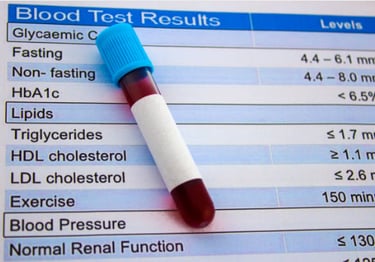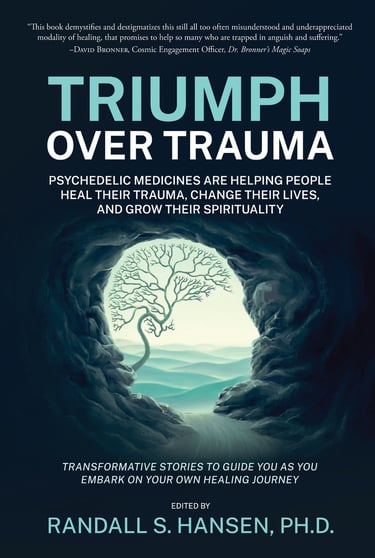Worried About Your Cholesterol and Triglycerides?
What do you know about cholesterol and triglycerides? You’ve likely had blood work done as part of a wellness exam and gotten your results, or perhaps you have seen one of more sensationalized headlines warning of the dangers of high cholesterol, or maybe you have seen one too many cholesterol medication ads while watching television.
The truth is that both cholesterol and triglycerides are normal and necessary for bodily functions. Cholesterol has received far too much focus while triglycerides not enough, but thanks to a shift toward metabolic health, we are much closer to understanding the key health indicators we all need to watch.
One final clarification before moving forward. Contrary to previous health claims you may have seen or heard, there is absolutely no proven connection between dietary cholesterol (found in eggs, cheese, red meat, etc.) and cholesterol levels in your blood because the cholesterol you eat is minimally absorbed by your body. Furthermore, there is NO connection between dietary cholesterol and heart disease.
In reality, it’s not the cholesterol you should be most concerned with, it’s the chronic inflammation in your body, but let’s start with cholesterol and triglycerides, which are easily measured.
Triglycerides and Cholesterol Explained
First things first. Both triglycerides and cholesterol are lipids (fats) that circulate in the blood and which are critical in supporting bodily functions.
Triglycerides are the most common form of fat in the bloodstream. Most of your body's fat is stored as triglycerides, which are created in the liver when we eat more than the body needs, and especially when we consume excess refined sugars and simple carbohydrates. Other factors that can raise triglyceride levels include excess weight and obesity, smoking, and heavy alcohol use.
Having high levels of triglycerides is often a sign of prediabetes or Type 2 diabetes, and definitely a warning sign for metabolic health issues.
Cholesterol is a waxy, fatty substance produced by every cell in your body, and is used for building cells and certain hormones. We make all of the cholesterol needed for the body to function. Cholesterol is further broken down into two types: low-density lipoprotein (known as LDL) and high-density lipoprotein (HDL).
In the past, LDL was seen as the “bad” cholesterol, but in reality, we need both types of cholesterol, and research clearly demonstrates that three-quarters of heart attack sufferers do not have high LDL levels.
While most doctors simply test for an overall LDL level, the most important number to know is not total LDL, but actually a subclass that are small, dense LDL particles found to more likely oxidize and lodge themselves to arterial walls. These Lipoprotein (a) or Lp (a) are significantly associated with increased risks of heart attacks (known medically as myocardial infarctions).
Instead of just the standard lipid panel for measuring LDL and HDL, you can request your doctor also do an Apo B (Apolipoprotein B -100) test, which is more accurate than a lipid panel in estimating cardiovascular disease risk because it measures your apolipoprotein B, which attaches to the types of cholesterol that cause plaque buildup in your blood vessels. A normal range for this test is from about 60-120 mg/dl, but varies slightly by gender. If your Apo B is higher than 120 mg/dL, you’re likely at a higher risk of heart and blood vessel disease.
Naturally Managing Your Cholesterol and Triglycerides
The best tools you have for managing your cholesterol and triglycerides are following a healthy diet and living a healthy lifestyle.
Some specific suggestions:
Avoid most foods and beverages that contain added/excess refined sugars and simple carbs. Eliminate foods with high amounts of sugars, flours, and rice. This means eliminating most ultra-processed convenience foods.
Consume healthy fats, such as found in avocados, olives, nuts, seeds, fish, grassfed beef, and unflavored dairy products. (The goal is increasing the intake of Omega-3 fatty acids.)
Avoid foods with unhealthy fats and oils (including trans fats), such as processed and deli-style meats, margarines, vegetable “seed” oils, palm oil, and most deep-fried fast foods and store-bought baked products (including cookies, crackers, and cakes). These fats are high in Omega-6, which is inflammatory.
Eat more foods with healthy fibers, especially soluble fiber, which includes nuts and seeds, as well as a variety of vegetables and some fruits. (Flax and hemp seeds are great options here, as are psyllium husks, which can be mixed with water.)
Move all day, every day. While exercise does not directly lower cholesterol, it is essential for health. Complete a variety of exercises every day, including both aerobic movement (activities that get your blood and lungs pumping) and resistance training (to help build or maintain muscles). Aerobic activities include walking, biking, running, swimming, and dancing. Resistance training involves working various muscle groups and includes pushups, squats, lunges, yoga, and bands and weights.
Lose excess weight and maintain a healthy weight. The easiest way to achieve this? Simply start eating real foods, prepared at home using recipes that focus on low or no sugar meals. For most people, a high-carb diet translates to weight gain because all the excess carbs are converted to fat.
Manage/reduce chronic stress situations. There’s enough information that connects prolonged high stress with raising your risk of high cholesterol and heart disease. Consider changing jobs or relationships – wherever your chronic stress is originating.
Greatly reduce or eliminate alcohol consumption. The body basically metabolizes alcohol into sugar-like compounds, thus it has the same effect on the liver and body, storing the sugar as fat.
Quit cigarette smoking. Smoking has been shown to increase the risk for high cholesterol, heart disease and stroke, and other heart health issues.
Cholesterol, Triglycerides, and Metabolic Health
Metabolic health is one of the best measures of your overall health because you can look healthy but actually be quite sick, as weight/waistline is just one factor of metabolic health, and the other factors are unseen without testing. Note that metabolic health includes examining both triglycerides and HDL cholesterol.
The way doctors and scientists measure metabolic health is by using these five elements:
1. Blood pressure. Hypertension, or high blood pressure (130/85 or higher), which affects about half the U.S. population, is a negative sign of metabolic health. You can easily measure this for yourself, but do follow the guidelines of sitting with both feet on the floor and the cuff on your resting left arm.
2. Waistline. Health experts used to talk about weight and body mass index (BMI), but more recently researchers have found that measuring the waist is better. Having a waistline above 40 inches for men and 35 inches for women is a negative sign of metabolic health; this is another easy thing to measure for yourself.
3. Fasting glucose. Indicates how much sugar is in the blood after a period of no eating and only water consumption. Levels under 100 mg/dL are considered healthy; 100-125 mg/dL is considered prediabetic, and anything over 100 is considered a negative sign of metabolic health. This can easily be measured with a blood test – either with an at-home kit or a blood draw by a health professional.
4. Triglycerides. These are fats found in your blood, and play an important role in healthy body functions – until they become too concentrated. Triglycerides have been misunderstood for many years, in terms of the role they do or do not play in cardiovascular disease, but in terms of metabolic health, anything above 150 mg/dL and higher is considered unhealthy. This level can only be measured with a blood panel done by a health professional.
5. HDL cholesterol. Please note that much of what we once believed about cholesterol has now evolved, including the role that dietary cholesterol plays in levels of cholesterol in the body (which is negligible). Also note that this is HDL, the supposedly “good” cholesterol. In the case with HDL, low numbers are the concern, so a result of 40 mg/dL or less is considered unhealthy.
Metabolic Syndrome is when someone has negative markers for at least three of the five elements… and studies show that somewhere between a quarter and a third of the population has Metabolic Syndrome.
Final Thoughts on Triglycerides and Cholesterol
If you are not eating refined sugars and carbohydrates, then cholesterol should not be an issue for you, but always check with your doctor (not that most doctors understand nutrition). Consider asking for a blood panel that includes not just glucose levels, but also insulin levels.
The key is understanding that chronic body inflammation is at the core of almost all metabolic disorders and preventable diseases, including diabetes, heart disease, strokes, many cancers, and Alzheimer’s.
If you’re concerned about your heart health, please regularly monitor your LDL (and ideally ApoB) and triglyceride levels.
If your doctor recommends putting you on medication for your cholesterol – either statins or PCSK9 inhibitors – without discussing changing your diet and lifestyle, please find a new doctor. Some elements of cholesterol are related to your genes, but much more is controlled by lifestyle choices.
Recommended books to dive deeper include Robert Lustig’s Metabolical and Marty Makary’s Blind Spots.
Additional Sources on Triglycerides and Cholesterol
Dr. Randall Hansen is an advocate, educator, mentor, ethicist, and thought-leader... helping the world heal from past trauma. He is founder and CEO of EmpoweringSites.com, a network of empowering and transformative Websites, including EmpoweringAdvice.com.
He is the author of the groundbreaking Triumph Over Trauma: Psychedelic Medicines are Helping People Heal Their Trauma, Change Their Lives, and Grow Their Spirituality and the well-received HEAL! Wholeistic Practices to Help Clear Your Trauma, Heal Yourself, and Live Your Best Life.
His latest book is a true game-changer: The HEALing Revolution Diet: A Science-based Approach to Heal Your Gut, Reverse Chronic Illnesses, Lose Weight, Clear Your Mind, and Increase Longevity.
Dr. Hansen's focus and advocacy center around true healing ... healing that results in being able to live an authentic life filled with peace, joy, love. Learn more by visiting his personal Website, RandallSHansen.com. You can also check out Dr. Randall Hansen on LinkedIn.







